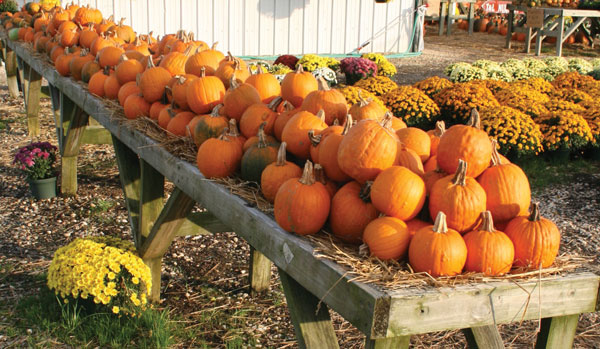November 25, 2013

The rainy summer of 2013 had vastly different effects on pumpkins grown in different locations.
In one widely quoted comment, pumpkin grower Sarah Weaver, owner of Sarah’s Pumpkin Patch in the town of Orange, Va., told a newspaper, “This has been my best year (ever) weather-wise.”
But Charles Tart of Dunn, N.C., south of Raleigh, had a much different experience. He lost essentially his entire crop because of all the water.
“Everyone had a lot of rain this year, but in this area, we really got hammered,” he said. “We had 48 inches of rain in a 26-day period in June and July.”
More from Southeast Farm Press
China making cotton market nervous
Double-crop wheat, soybeans good choice for second year running in Southeast
Growers should budget for FY14FSA program payment reductions
Farmland values down, income up for third quarter 2013
Making things worse, he grows many of his pumpkins on river land, and in 2013, that was not where you wanted to be.
“A lot of my pumpkins drowned,” he said. “We picked a few to sell at the state farmers market in Raleigh, but we didn't have any for our two retail stores.”
The lay of the land definitely made a difference, Tart said. Farmers who planted pumpkins on hilly land did better, but they still only got around 50 percent of a crop.
By October the supplies of pumpkins were ample, said Rick Cecil, Piedmont Triad Farmers Market near Greensboro, N.C.
Decorative gourds and other fall crops appeared to be in good supply also, he said.
Pumpkins in Virginia made it through the rainy season fairly well, according to the Virginia Department of Agriculture. The standard Jack-O-Lantern pumpkin may in fact be a little bigger and heavier this year because of all the precipitation.
That rain, which seemed constant at the start of the season, delayed planting, and in low-lying areas, some growers lost a few acres, said Elaine Lidholm of the Virginia Department of Agriculture. “Pollination and germination were slow because of the cool, wet late summer.”
Although the harvest was a little late this year, overall, the crop bounced back. “It won’t be a bumper crop but it will be a good crop, Lidholm said.
Individual pumpkin growers reported:
• Supplies were down slightly from last year, which was a banner season, said grower Jay Yankey of Prince William County, Va., near Washington, D.C. But the quality was excellent, with good size, color and stems.
Bad for pollination
• The wet, cool weather was bad for pollination and germination, said grower Travis Marshall from Hillsville in southwestern Virginia, and at one point he was a little concerned about the crop. But when harvest time came, the fields looked better than expected, except for a few bottom land acres where the pumpkins drowned.
• In western North Carolina, the 100 inches of rain that fell this year wreaked havoc on the pumpkin crop in the Blue Ridge region, said Mike Stepp of Hendersonville, N.C.
He owns a pick-your-own apple facility.
“We grow a few pumpkins to sell at the orchard,” he said. “But that crop was a disaster this year because of all the wet weather. We didn't produce many pumpkins at all.”
Finally, a buyer for a Virginia grocery chain said pumpkins got off to a two-week-late start compared to 2012, said Mike Lipton of the Food City chain.
“With all the wet weather over the last few months, the expectation of quality was questionable,” he said. “However, we are seeing great sizing, and the quality of the pumpkins has been outstanding so far.”
Supply was catching up with the demand in early October. “Consumers were beginning to decorate for fall with pumpkins and mums,” he said. “We are expecting sales to be as strong as last year even with the shorter window of sales opportunity.”
This was by far the wettest weather that John Bynum had ever seen during land preparation.
“It got wet. It stayed wet. We couldn't get in when we wanted,” said the Garner, N.C., pumpkin and mums grower.
“I finally got in and laid my pumpkin crop by. Leaching was a problem right after planting. There were nitrogen deficiencies in lighter land. I had to add more nitrogen.”
There was a big canopy of vines with no root system to support it. Then, after fruit set, it got dry, and the vines suffered.
“And we had a lot of mildew, including the dry mildew. We had a dry northeast wind blowing all the time, and that made conditions better for the dry mildew. We had to spray every three to five days.”
“I made about three times as many sprays as normal,” he said.
“After all that, I actually ended up with a very good crop,” he said. “It was better than average. The number of sellable pumpkins is up about 20 percent above average.”
All that disease control spraying and leaching adjustment, however, made this an expensive crop to produce.
“But you can't cut back on the necessary practices,” said Bynum. “And you absolutely have to do the things that need doing when they need to be done. That is really important with pumpkins ― they say that if you see a little bit of fungus on the vines today, you need to spray, because the whole field will have it tomorrow.”
You May Also Like




